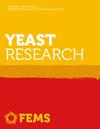Isolation and characterisation of Saccharomyces cerevisiae mutants with increased cell wall chitin using fluorescence-activated cell sorting
IF 2.4
4区 生物学
Q3 BIOTECHNOLOGY & APPLIED MICROBIOLOGY
引用次数: 0
Abstract
Yeast cell wall chitin has been shown to bind grape pathogenesis-related chitinases that are the primary cause of protein haze in wines suggesting that yeast cell walls may be applied for haze protection. Here we present a high throughput screen to identify yeast strains with high cell wall chitin using a reiterative enrichment strategy and Fluorescence-Activated Cell Sorting of cells labelled with either GFP-tagged chitinase or with Calcofluor White. To assess the validity of the strategy, we first used a pooled deletion strain library of Saccharomyces cerevisiae. The strategy enriched for deletion mutants with genes that had previously been described as having an impact on chitin levels. Genes that had not previously been linked to chitin biosynthesis or deposition were also identified. These genes are involved in cell wall maintenance and/or membrane trafficking functions. The strategy was then applied to a mutagenized population of a commercial wine yeast strain, Saccharomyces cerevisiae EC1118. Enriched mutant strains showed significantly higher cell wall chitin than the wild type and significantly reduced the activity of chitinases in synthetic model wine, suggesting that these strains may be able to reduce haze formation in wine.利用荧光激活细胞分选技术分离细胞壁几丁质增加的酿酒酵母突变体并确定其特征
酵母细胞壁几丁质已被证明能与葡萄致病相关的几丁质酶结合,而葡萄致病相关的几丁质酶是造成葡萄酒中蛋白烟雾的主要原因,这表明酵母细胞壁可用于烟雾防护。在此,我们介绍了一种高通量筛选方法,利用重复富集策略和荧光激活细胞分选技术,对标记有 GFP 标记几丁质酶或钙氟白的细胞进行筛选,以鉴定具有高细胞壁几丁质的酵母菌株。为了评估该策略的有效性,我们首先使用了一个集合的酿酒酵母缺失菌株库。该策略富集了以前被描述为对几丁质水平有影响的基因的缺失突变体。此外,还发现了以前与几丁质生物合成或沉积无关的基因。这些基因参与了细胞壁的维护和/或膜运输功能。然后将该策略应用于商业葡萄酒酵母菌株 Saccharomyces cerevisiae EC1118 的诱变群体。富集突变菌株的细胞壁几丁质含量明显高于野生型,并显著降低了合成模型酒中几丁质酶的活性,这表明这些菌株可能能够减少葡萄酒中雾霾的形成。
本文章由计算机程序翻译,如有差异,请以英文原文为准。
求助全文
约1分钟内获得全文
求助全文
来源期刊

FEMS yeast research
生物-生物工程与应用微生物
CiteScore
5.70
自引率
6.20%
发文量
54
审稿时长
1 months
期刊介绍:
FEMS Yeast Research offers efficient publication of high-quality original Research Articles, Mini-reviews, Letters to the Editor, Perspectives and Commentaries that express current opinions. The journal will select for publication only those manuscripts deemed to be of major relevance to the field and generally will not consider articles that are largely descriptive without insights on underlying mechanism or biology. Submissions on any yeast species are welcome provided they report results within the scope outlined below and are of significance to the yeast field.
 求助内容:
求助内容: 应助结果提醒方式:
应助结果提醒方式:


